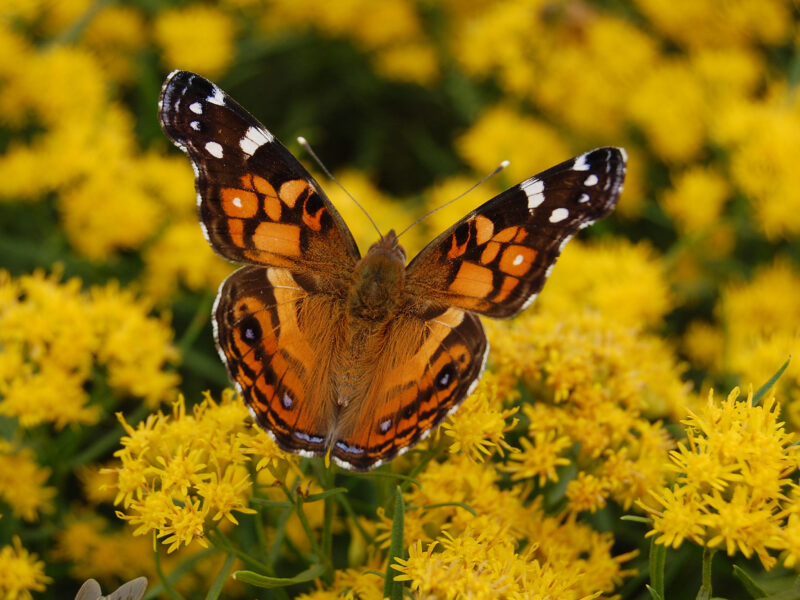
Who invented the butterfly? God? They are all so goddamned beautiful, yet so delicately assembled … one wonders how they have made it all of these years.
Now we learn that they are not only exquisite to behold but a few of them can fly extraordinary distances that even rival the thousands of miles that shorebirds, terns, geese and many oceanic birds fly every year north and south.
We mortals, on the other hand, are poor locomotors. We can’t fly! Yes, we can walk and run, but almost all of our mammal kin can walk and run much faster. We are stuck in our home latitude, except when taking a commercial airline flight to someplace north or south.
In 1975, because of the painstaking work of Frederick Urqhuart, we already knew about migrating monarch butterflies. What we didn’t know before that fateful year was that some mountainous forests in central Mexico had been hosting millions of monarchs, year in and year out, for centuries. And they still are.
Then, more recently, we found out that a butterfly that is as ornately colored as the monarch, the painted lady, Vanessa cardui, flies 4,000 miles a clip from Iceland to the Sahara Desert and beyond.
Monarchs we can see while en route to that tropical overwintering locale, but the painted ladies’ migratory flight is thousands of feet above land. We had to find out by other means.
If you lived on a coastal island between here and that monarch overwintering forest, and you tried to survive by eating passerby monarch butterflies, you would spit them out before swallowing them the way wild birds do — they taste awful!
Why? Because monarch caterpillars feed on milkweeds, which contain poisonous chemicals called glucosides. These poisons are retained by the adults after emerging from the pupae. Any bird that tries to eat a monarch soon learns how bad it tastes. Apparently, one bite lasts forever.
Thus, the monarch does not go out of its way to avoid predators. A monarch look-alike butterfly, the viceroy, feeds on pollen and sap that does not contain milkweed poisons, and thus it is not bad tasting, yet because it mimics the look-alike monarch in coloration, it escapes most predators.
Such is an example of Batesian mimicry. However, the recent research shows that some viceroys feed on bad-tasting flowers, which, in turn, makes them unpalatable from the start.
While new findings are awaited to clarify the discrepancies, the painted lady, unfortunately, feeds on flower products that are not toxic, and so is quite palatable. It escaped predation by flying way up high.
Almost all butterflies engage in up-and-down flight, which helps them avoid predation. They beat their wings all the while, some 300 to 600 times per minute. The painted lady occurs throughout Eurasia and North America. The American lady, Vanesa virginiensis, has two large eye spots (“ocelli”) on its hind wings, instead of the four smaller ocelli on the hind wing in the painted lady. Both species are found throughout North America.
The painted lady feeds on purple flowers, as well as mallows, thistles and nettles, while the American lady prefers sunflowers and other members of the composite family.
The number of painted lady and American lady enthusiasts is paltry when compared to the number of monarch butterfly students and observers. On Long Island alone, there are several organizations counting monarchs and collecting information on them.
This past year, the species has been listed as endangered by the International Union for the Conservation of Nature, which now lists the monarch in its “Red” book.
Locally, Victoria Bustamante has been keeping count of the number of monarchs she sees each year. As of August 23, she’s recorded 55.
Matthew Galcik has a house on the west side of Lake Montauk. He plants different milkweeds in his yard each year. He has at least 10 monarch larvae and pupae recorded. He moves some of them into spots where they will be less likely harmed.
Jean Held, one of the area’s most gifted naturalists and photographers, keeps a close eye on butterflies that visit the plants that she cultivates in her garden in eastern Sag Harbor. She has butterfly plants, special parts of which are still blooming. She moves the monarch nests inside to protect them. She also has painted ladies and American ladies.
On the other hand, I have butterfly weeds growing in my yard in Noyac. And though I examined them each day for the two-plus weeks they were in bloom, I had nary a monarch. Perhaps, I am too close to the highway. I also keep track of the traffic each day and between 6 a.m. and 6 p.m. during spring and summer, I get about 1,200 vehicles passing each hour. That traffic accounts for the numerous bad air reports from AccuWeather each week.
The bad air may keep the monarchs away from the yard, but it doesn’t seem to discourage the cabbage whites that fly back and forth, stopping now and then to feed. They are another contribution from Eurasia. They seem to do well in the bad air!